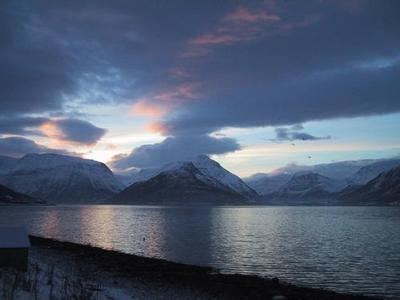Country Norway District Nord-Troms Area rank 106 in Norway Population 2,210 (2012) Official language forms Bokmål, Northern Sami | County Troms Administrative centre Olderdalen Demonym(s) Kåfjording Local time Sunday 7:21 PM | |
 | ||
Weather -4°C, Wind S at 8 km/h, 70% Humidity Area 991.1 km² (950.2 km² Land / 40.86 km² Water) Points of interest Halti, Spåkenes coastal fort, Storkebergsfjæra, Staffuranta, Kveita, Reašši, Sáttu, Jiellegáddi, Irvi | ||
Gáivuotna (Northern Sami) or Kåfjord (Norwegian), (also Kven: Kaivuono) is a municipality in Troms county, Norway. The administrative centre of the municipality is the village of Olderdalen. Other villages include Manndalen, Birtavarre, Trollvik, Samuelsberg, Nordmannvik and Djupvik.
Contents
- Map of KC3A5fjord Municipality Norway
- General information
- Name
- Coat of arms
- Churches
- History
- Government
- Municipal council
- Geography
- Economy
- Population
- Notable residents
- References
Map of K%C3%A5fjord Municipality, Norway
General information
The municipality of Kåfjord was established in 1929 when it was separated from the municipality of Lyngen. The initial population of Kåfjord was 2,482. Then on 1 January 1992, the Nordnes area of Lyngen (population: 38) was transferred to Kåfjord.
Name
Kåfjord is a Norwegianized form of the Sámi name Gáivuotna. The meaning of the first element is unknown and the last element is vuotna which means "fjord".
The name of the municipality was Kåfjord until 2 May 1994, when it was changed to Gáivuotna–Kåfjord It was the fifth municipality in Norway to get a Sami name. In 2005, the name was again changed such that either the Sami Gáivuotna or the Norwegian Kåfjord name can be used.
Coat-of-arms
The coat-of-arms is from 1988. It shows a silver spinning wheel on a red background. This was chosen to reflect the crafts and traditions of the local community.
Churches
The Church of Norway has one parish (sokn) within the municipality of Gáivuotna–Kåfjord. It is part of the Nord-Troms deanery in the Diocese of Nord-Hålogaland.
History
In 1945, the villages of Kåfjord were burned to the ground during the retreat of German forces from Finland and Finnmark. This was as far west as the Wehrmacht used their scorched earth tactics.
Government
All municipalities in Norway, including Kåfjord, are responsible for primary education (through 10th grade), outpatient health services, senior citizen services, unemployment and other social services, zoning, economic development, and municipal roads. The municipality is governed by a municipal council of elected representatives, which in turn elect a mayor.
Municipal council
The municipal council (Kommunestyre) of Kåfjord is made up of 17 representatives that are elected to every four years. Currently, the party breakdown is as follows:
Geography
The municipality is situated on the eastern side of the Lyngen fjord, and around its eastern arm, the Kåfjord. The municipal centre is Olderdalen. Other villages include Birtavarre, Kåfjorddalen, Djupvik, Nordmannvik, and Manndalen, where the international indigenous peoples' festival Riddu Riđđu is hosted each year.
On the border with Finland, is the mountain Ráisduattarháldi which has a height of 1,365 m (4,478 ft).
Economy
Fishing and small-scale farming have been the most important sources of income. Now many people work in education and other public services. The population has declined for many years, but the decline is now less rapid than earlier. A new optimism has arisen among young people, largely due to the increasing cultural activities.
Population
The majority of the population is of Sami origin. Due to assimilation pressure from the Norwegian State, the language was largely lost in the 20th century. Now efforts are being made to reintroduce Sami, largely concentrated in the municipality's largest village, Manndalen/Olmmáivággi.
Notable residents
Erik Johnsen (1844–1941), a Laestadian preacher. He received the King's Medal of Merit (Kongens Fortjenstmedalje) in 1938 for his work for the salvation of the soul.
